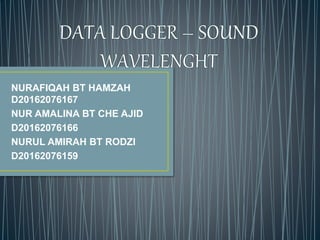
Data logger- Sound Wavelenght
- 1. NURAFIQAH BT HAMZAH D20162076167 NUR AMALINA BT CHE AJID D20162076166 NURUL AMIRAH BT RODZI D20162076159
- 2. • COMPUTER = Utilize software – to read info from sensor • DATA LOGGER = Instrument – record measurement – time • Compact – battery-powered – internal (microprocessor, data storage, sensor) • SENSOR = Convert (Physical Quantity TO Electrical Signal) • Type: light, temperature, sound, pH, Humidity
- 3. • ATTENUATION OF ULTRASOUND IN SOLID • How the damping of sound in solid can be determined? • The damping of sound in solids shall be determined for 3 different frequencies in reflection as well as transmission and be compared with values from the literature. • Sound wave running through a medium loses energy at different process (scattering, adsorption, reflection) • The intensity of the wave obeys the attenuation law 𝐼 = 𝐼˳𝑒−𝜇𝓍
- 4. • Objective: • To study the attenuation of ultrasound in solid. • Apparatus/materials: • Ultrasonic echoscope GAMPT-Scan (UEGS) • 2X ultrasonic probe 1 MHz • 2X ultrasonic probe 2 MHz • 2X ultrasonic probe 4 MHz • Ultrasonic test cylinder set • Ultrasonic gel • Calliper/probe holder
- 5. 1) Set up the ultrasonic echoscope GAMPT-Scan by adjusting the settings, to detect back wall echo and transmission pulse. Set the software to HF+ Amp representation. 2) Measure all length of the cylinder with calliper. 3) Connect the UEGS to the PC or laptop. 4) Insert the probes into the probe holders and connect the two probes of 1MHz frequency to the probe connector and switch is set to the ‘Trans’. 5) Insert the cylinder into the holder block start with shortest one. 6) Connect the probes to a cylinder with the aid of a drop of ultrasonic gel. 7) Set the gain and transmission values so that the signals for the shortest cylinder are not overdriven but are still as high as possible. 8) Make sure the gain settings are always identical in order to be able to compare the various amplitude measurements. 9) After the data is recorded, clean the cylinder and both of the probes 10) Repeat the experiment using another cylinder. 11) Repeat the experiment using 2 MHz and 4 MHz probes.
- 8. 1. How is an ultrasound performed? 2. Is ultrasound radiation? 3. The lowest rate of ultrasound absorption occurs in? A. Fat B. Air C. Bone D. Lung
- 9. 1. The traditional ultrasound procedure involves placing gel on abdomen to work as a conductor for the sound waves. A transducer used to produce sound waves into the uterus. The sound waves bounce off bones and tissue returning back to the transducer to generate black and white image. 2. No. Ultrasound uses sound wave. 3. Fat. Because air, bone and lung are high absorbers.
- 10. FALSE. TRY AGAIN
- 11. • Diagnostic Ultrasound • High frequency sound waves emitted from sound source (transducer) • Transducer placed on patient’s body • Sound waves echo off interfaces of internal structures and return to transducer • Information is processed and displayed on a monitor based on time and intensity of returning echo • Special term used on ultrasound reports Echogenic, Hyperechoic, Hypoechoic, Anechoic
- 12. • Diagnostic Ultrasound Interfaces are the signal sources Major application: Gall bladder evaluation Fluid collections Differentiation of cysts from solid Fetal evaluation Solid organ evaluation, heart, liver pancreas, kidney
- 14. • Used in teaching and learning and also help student to conduct experiment by using data logger device. • Improve critical thinking when answering tough question by apply the concept.